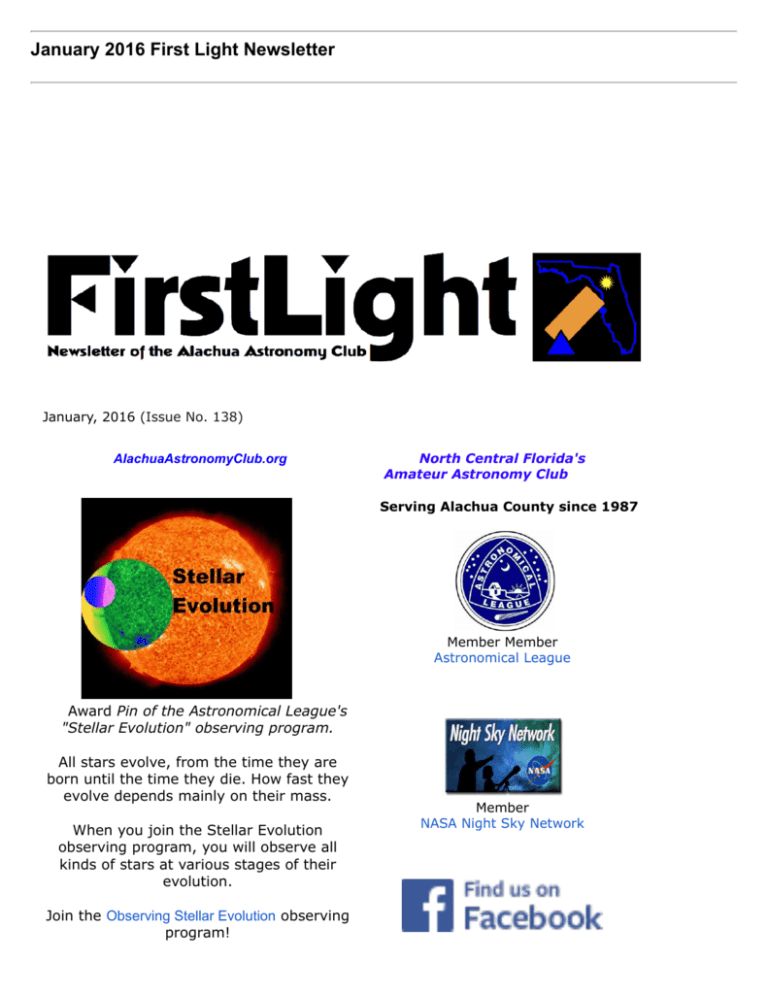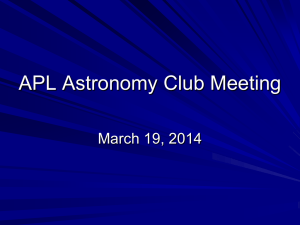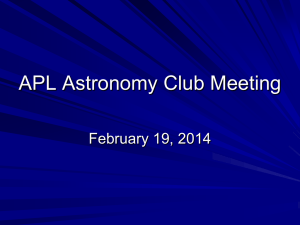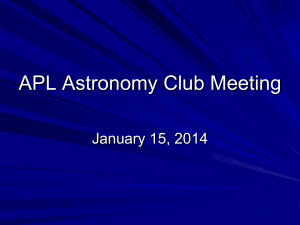
January 2016 First Light Newsletter
January, 2016 (Issue No. 138)
AlachuaAstronomyClub.org
North Central Florida's
Amateur Astronomy Club
Serving Alachua County since 1987
Member Member
Astronomical League
Award Pin of the Astronomical League's
"Stellar Evolution" observing program.
All stars evolve, from the time they are
born until the time they die. How fast they
evolve depends mainly on their mass.
When you join the Stellar Evolution
observing program, you will observe all
kinds of stars at various stages of their
evolution.
Join the Observing Stellar Evolution observing
program!
Member
NASA Night Sky Network
How will we finally image the event horizon of a
black hole?
by Ethan Siegel
Space Place Feature article
One hundred years ago, Albert Einstein first put forth his theory of General Relativity, which
laid out the relationship between space-time and the matter and energy present within it.
While it successfully recovered Newtonian gravity and predicted the additional precession of
Mercury's orbit, the only exact solution that Einstein himself discovered was the trivial one:
that for completely empty space. Less than two months after releasing his theory, however,
the German scientist Karl Schwarzschild provided a true exact solution, that of a massive,
infinitely dense object, a black hole.
One of the curious things that popped out of Schwarzschild's solution was the existence of
an event horizon, or a region of space that was so severely curved that nothing, not even
light, could escape from it. The size of this event horizon would be directly proportional to
the mass of the black hole. A black hole the mass of Earth would have an event horizon less
than a centimeter in radius; a black hole the mass of the sun would have an event horizon
just a few kilometers in radius; and a super massive black hole would have an event
horizon the size of a planetary orbit.
Our galaxy has since been discovered to house a black hole about four million solar masses
in size, with an event horizon about 23.6 million kilometers across, or about 40 percent the
size of Mercury's orbit around the sun. At a distance of 26,000 light years, it's the largest
event horizon in angular size visible from Earth, but at just 19 micro-arc-seconds, it would
take a telescope the size of Earth to resolve it – a practical impossibility.
But all hope isn't lost! If instead of a single telescope, we built an array of telescopes
located all over Earth, we could simultaneously image the galactic center, and use the
technique of VLBI (very long-baseline interferometry) to resolve the black hole's event
horizon. The array would only have the light-gathering power of the individual telescopes,
meaning the black hole (in the radio) will appear very faint, but they can obtain the
resolution of a telescope that's the distance between the farthest telescopes in the array!
The planned Event Horizon Telescope, spanning four different continents (including
Antarctica), should be able to resolve under 10 micro-arc-seconds, imaging a black hole
directly for the first time and answering the question of whether or not they truly contain an
event horizon. What began as a mere mathematical solution is now just a few years away
from being observed and known for certain!
Note: This month’s article describes a project that is not related to NASA and does not
suggest any relationship or endorsement. Its coverage is for general interest and
educational purposes.
Image credit: NASA/CXC/Amherst College/D.Haggard et al., of the galactic center in X-rays.
Sagittarius A* is the supermassive black hole at our Milky Way's center, which normally
emits X-ray light of a particular brightness. However, 2013 saw a flare increase its
luminosity by a factor of many hundreds, as the black hole devoured matter. The event
horizon has yet to be revealed.
Newberry Star Park
by Andy Howell
New in-use outlet
covers were installed
at the eight
observing pads
earlier in December.
They're constructed
of rugged metal and
should be less prone
to damage or
breakage when
bumped into by
machinery.
We always have ants
that want to observe
with us at the
monthly star parties.
We don't mean to be
bad hosts, but we
periodically sprinkle
the observing area
with ant killer.
Otherwise, ants
would come over and bite observers when they're kneeling on the ground as they peer
through finder scopes.
The new paint job and bold, black lettering are holding up well to the weather. We still need
to replace damaged skirting around the base of the building. Another thing that needs doing
is spreading drainage gravel under the eaves to prevent dirt splashing up onto the siding
during rain storms.
It would be good to install a fence perimeter with a setback of about five feet to prevent
vehicles from getting too close to the building. Early last year, an RV bumped into the WiFi
antenna, tearing it loose from the building. As a preventive measure, a temporary fence
should probably be installed prior to big events when RVs park on the property.
Newberry Star Park is being used 24/7 with the Mallincam all-sky camera that operates day
and night. See what sky conditions are now by clicking HERE. The SkySentinel meteor
camera at Newberry Star Park also operates during nighttime. During the past half year, it's
imaged over 100 fireballs with a spectacular mag -18 fireball appearing early in November.
The Mallincam and SkySentinel cameras are automated so that they are almost always
collecting data. Thanks to a grant from Charlie Jarman, we'll be installing a 1TB hard drive
to archive Mallincam images at one-minute intervals. When something interesting like a
bright fireball makes its appearance, then we'll be able to play it back for further study.
Pictured on the left is a fireball that
appeared at 3:36am in the skies over
Newberry Star Park on the morning of
December 29. North is up, and West is
to the right. Imagine lying on the
ground, flat on your back, with head to
the north. That will make the image
match what you would see with your
eyes.
Next star party & outreach at Newberry
Star Park is scheduled January 16,
Saturday from 5:30-11:00pm. Join us!
Register HERE for January's Public Star
Party & Outreach at Newberry Star
Park.
Star Parties
by Lisa Eager and Ivo Rabell
Newberry Star Park Star Party/Public
Outreach
December 12, 2015
Photo below is a terrific image of the Orion Nebula taken by David Liles using his 9.25 inch
Celestron Schmidt-Cassegrain telescope at December's star party and outreach at Newberry
Star Park. David traveled all the way from Live Oak to join in the fun. Thank you, David!
Andy did a really
spot on job of
calling the
conditions for
Saturday night's
Star Party at NSP.
Early on we got to
see a sliver of a
moon as it set with
some wispy clouds
going on. Ed, aka
Cloud, was a bit
skeptical and didn't
hurry putting up his
equipment, but then
took a chance and
ended up being the
last one to leave!
We hosted about 9
guests with just a
few telescopes. Everyone enjoyed the sights and information that we shared with them, so
we may have a new AAC member or two (?)
As Andy predicted around 9 pm things started to clear up so we went sky hopping and
showing guests a myriad of deep sky objects, which means that Tass was around, so a
hopping we did go! And the guests had a blast trying to absorb it all.
While most of us were on a whirlwind tour of the universe, Andy stayed busy helping Rick
get the club's LCM 114 Celestron up to speed, then he worked with some guests
troubleshooting with their telescope. I guess he can add "telescope repairman" to his list of
job duties! Andy, we all REALLY, REALLY, appreciate all that you do for the club!
Here's who showed up for members:
Rick Garnsey with the club's LCM 114 Celestron
Winnie McDavid
David Liles with his 9 1/4" Celestron SCT on a CGEM mount
Tass Karahalios
Spinuzza Family
Ed Honkus with his 10" SCT
JoAnn Stevener
Andy Howell
Lisa Eager with my 10" trusty Dobsonian
Imagine my shock at seeing David showing up to NSP for a star party, a Christmas miracle?
Well, maybe not up to "miracle" status, but not an everyday occurrence. He had his Nikon
1V1 with FT1 adaptor at ISO1600. an IR remote trigger. His criteria for imaging was "pick a
sucker hole and shoot". We'll share some of those photos. There were visitors that were
very interested in photography and got a lot of information from David.
Some of the visitors that came out to enjoy were:
Carlton Oglesby
Jing Zhung
Jerome Medeli
Steven Mothersheal
Nikki Evirs
Jeremy Evirs
Barbara Schmidt
Randy Webb
Some of the favorites for the night were the Geminid meteors and everyone loved NGC
2262 Hubble's Variable Nebula, Caroline's Rose NGC 7789 was pretty impressive also.
So all in all a successful star party with some challenges going on from the laser tag folks
next door. We'll have to work on getting them to put on their parking lights when they
come and go. Until next year, clear skies!
Lisa Eager
Public Outreach Coordinator
Holiday Party at the Barnett Residence
December 5, 2015
Once again this
year, Mark and
Cindy Barnett
graciously opened
their home to host
the annual Alachua
Astronomy Club
Holiday Party. And
what a party it
was!
Approximately 50
members
accompanied by
family members
attended. There
was excellent food
and drink, prizes,
the famous astro
quiz, and awards
presentations.
Mike Toomey and
Tim Malles were recognized with Star Awards for their contributions to the Club. Mike
Toomey, in case you don't know, is the current schools coordinator. In previous lives,
Mike has served as President, Secretary, FirstLight Editor, and Star Party
Coordinator. Tim Malles is the coordinator of the annual Kanapaha Botanical Gardens
Moonlight Walk, scheduled again for May 14th this year. Tim served as Programs
Chair several years ago and did great work in this very important volunteer position.
Tim had a big role in erection of the Solar Walk along 8th Avenue, installed in 2002.
(Visit our Solar Walk web page HERE.)
The following members received certificates of recognition for their contributions of
time and energy during the year:
Brendan Barraclough
Chuck Broward
Jerry Cheney
Howard Cohen
Marian Cohen
Lisa Eager
Jared Feldman
H.A. Grabbe
Marlene Grabbe
Gay Haldeman
Joe Haldeman
Richard Hennig
Andy Howell
Alicia Kemper
Robert Munyer
Pam Mydock
Ivo Rabell
Rich Russin
Frances Seiler
Susan Sorrell
JoAnn Stevener
Mike Toomey
Cheryl Troupe
John Troupe
Recognition was based on information logged in the Track It Forward web site
accessible HERE. Log your time when doing volunteer work for the Club!
Mark and Cindy Barnett, hosts of the annual Holiday Party, receive "Year of Pluto" Tshirts from AAC president Andy Howell. Thank you, Mark and Cindy, for hosting the
party!
Starry Night at FMNH
November 13, 2015
Starry Night at the Florida Museum of Natural History was incredible!
From left to right are AAC members Ivo Rabell, Chuck Broward, Judy Broward, and
Tim Malles. Starry Night at the Florida Museum of Natural History is one of the
premiere Alachua Astronomy Club outreach events during the year.
Over 2200 visitors toured the museum and looked through our telescopes. But
only six of our members brought telescopes. Needless to say, we were all
overwhelmed.
Saw Greg Beckner before the madness started and said he was going to show the
Dumbbell Nebula. If he was able to show the dumbbell, I’m sure it looked like a fuzzy
thumbprint due to parking lot and garage lights not being covered. Put a crimp on
what was a very clear night sky.
Starting around 5:30 pm saw Don Loftus and lovely wife showing 2 day old waxing
crescent Moon on his home crafted 6” Newtonian to a long line of visitors. Starry
Night was not supposed to start until 6:00 pm. You would have never known!
Across the street Rich Russin set up his reflector and showed Albireo and I believe
the Ring Nebula.
Bill Elliot set up his reflector next to Greg and had long lines. Bill was sky hoping
from Nebulas to Galaxies.
With all the light pollution Lisa Eager with her 10” Dob and eagle eyes was able to
spot the double in Perseus.
Jerry Cheney got the worst of the crowds. After a couple of hours of showing Albireo
I switch to the Pleiades with my binoculars. I had to instruct viewers how to use the
binoculars and it was taking so long that I started directing visitors lined up on my
telescope to Jerry’s line. Poor guy, he almost lost his voice.
We all talked non-stop for a minimum of 4 1/2 hours explaining sky denizens on our
scopes eye pieces to visitors. Most of us have sore throats this morning.
I want to thank Chuck and Judy Broward for helping Pamela Mydock, who had a mob
in front of her as early as 5:30 pm for helping with AAC table and handouts.
Crill Hintermister brought his binoculars and walked around showing the Pleiades and
later Orion’s Nebula.
Saw Robert Munyer, Matt Given and his spectacular girl friend Morgan Gates but I
was so busy couldn’t tell what they did.
As always, Joann Stevener went around bringing water bottles and food to all
telescope volunteers.
Tim Malles had he gorgeous 3D space art displayed inside of Museum.
Last but not least, I really appreciate AAC President Andy Howell, for last minute
cruising all the way to Newberry to retrieve AAC’s huge banner and setting it up.
Whoops, on me!
My deepest gratitude to all Alachua Astronomy Club volunteers, you all did one
amazing job!
Ivo Rabell, Outreach Coordinator
Schools and Outreach
by Mike Toomey
Our next evening school star party will be at an elementary school
on the east side of Gainesville on Thursday, January 24 (please
register on the website or contact me for the exact location). We
expect at least 70 – 80 students in addition to many parents, so
we'll be needing at least 4 or 5 telescopes and operators. The sun
will set shortly before 6pm, so we'll be up and running at 6:15pm.
The 5 day old moon will be well positioned in the sky even before
sundown.
On Tuesday, January 19, we need volunteers for an afternoon
program, also on the east side. These are short programs (a little
under an hour) typically for 15 – 20 students in 4th and 5th
grades. The kids are hyper-enthusiastic so the hour really flies
by. Again, please use the website to register and discover more details of these afterschool programs.
Unfortunately, we were rained out for our December school program. I will try to
reschedule that for later in the year. However, before I can do that, we really need an influx
of new volunteers. It will be difficult to sustain our programs otherwise. You do not need
to be an expert in astronomy to be an outreach volunteer. You do not even need to own a
telescope! You can shadow current volunteers at events, ask our Sky Mentor Bill Helms or
other members for one-on-one assistance with your telescope, or be brought up to speed
with one of several club-owned telescopes. Binoculars are also excellent astronomical
instruments that can be hand-held or tripod-mounted.
Mike Toomey has served the AAC in many capacities since 1998, including President,
Secretary, FirstLight Editor, Star Party Coordinator and School Outreach Coordinator. Mike
resides in Gainesville.
Name ExoWorlds Winners Announced!
by Andy Howell
International Astronomical Union (IAU)
Press Release (12/15/2015): The votes
are in — the names of 19 ExoWorlds
(14 stars and 31 exoplanets orbiting
them) have been chosen by public vote
in the NameExoWorlds contest and
accepted by the IAU. Reflecting the
truly international interest in astronomy,
over half a million votes from 182
countries and territories have
contributed to the new official
designations of the alien worlds.
Learn more: IAU Press Release
Alachua Astronomy Club earned 2nd Place in the vote to rename Upsilon
Andromedae. Based on an internal Club vote earlier during 2015, we had proposed
the following names to the International Astronomical Union:
Upsilon
Upsilon
Upsilon
Upsilon
Andromedae
Andromedae
Andromedae
Andromedae
(star) - Verne
b (planet) - Heinlein
c (planet) - Asimov
d (planet) - Clarke
Oh so close! Out of the thousands of votes cast, we fell just 83 votes behind the
winning proposal submitted by the Vega Astronomical Club (Morocco). Regardless,
we thank Gay Haldeman and all who voted in the contest on behalf of our (nearly)
winning submission. Our proposal garnered over 2,000 votes, just 83 shy of the
winning proposal by Vega Astronomical Club.
Coming Up: After extensive deliberation, the IAU Committee decided to annul the
vote for one particular ExoWorld — tau Boötis — as the winning name was judged
not to conform with the IAU rules for naming exoplanets. To this end, the IAU will
organise a new contest to decide the name of tau Boötis in the future.
Meetings
AAC Public Meeting
Tuesday, January 12, 2016
7:00pm
Join us for an exciting and interesting evening at the Kika Silva Pla Planetarium (Santa Fe
College), 3000 NW 83rd Street, Building X-129, Gainesville, FL 32606
Speaker: James Albury, Planetarium director and co-host of the weekly TV show
"Stargazers."
New Members since November 1!
President
Andy Howell
Jonathan Bear
Del Schier
William Elliott
Steven Freymann
Basset Gilles
Ankur Jain
Phil Nolden
Burton Patterson
First Light Editor
Laura Wright
Happy New Year!
I have good news and bad
news. The good news is that club
membership counts 143 members. This
is up well over 50% in the past three
years!
The bad news is that volunteer
participation is not growing at the same
rate. For all of 2015, volunteer
participation was as follows:
Category
# Volunteers Hours
Public Outreach
13 143.5
School Outreach
7 89.5
Star Parties
12 84.5
TOTAL
19 350.0
(Data Source: Track It Forward volunteer
tracking database.)
This is a meager 13% (19/143)
participation rate. We can (and should)
do better!
There are two key TAKEAWAYS:
1. When you volunteer for the Club,
please LOG YOUR TIME at Track It
Forward. First, we want to recognize your
volunteer contributions at the annual
holiday party. (If you didn't attend last
month's party, you missed a great one!)
Second, we are a non-profit with one of
our missions being to "make astronomy
more accessible and visible to the
general public." When membership
doesn't support the mission, it hurts!
2. Critically, Alachua Astronomy Club
NEEDS YOU to get involved in schools
and public outreach. The consequence of
not getting more membership
participation is that we may have to
scale back our outreach activities for
2016.
PLEASE VOLUNTEER. Our school
outreach and public outreach events are
Andy Howell suggested taking a
look at Gay Haldeman's
recommended link below. It is a
scale model of the solar system,
when the moon is 1 pixel wide.
"A Tediously Accurate Map of the Solar System”
I am always amazed at the many observing
programs and clubs available on the
Astronomical League's website. This month
the Observing Stellar Evolution program
with Bill Pellerin from Houston, TX as
coordinator caught my eye. In his
introduction he says " Everything that you
see in the night sky is visible to you
because of light from a star. We exist
because stars exist." "The purpose of this
club is to develop in the observer an
appreciation for the most common objects
that they see in the night sky-stars.
Understanding 'stellar evolution' is
important to understanding how the
universe works." This program will be of
interest to beginning observers as well as
more experienced observers and many
objects in the list are easy naked eye
objects.
Please, check on rules and reguations for
this observing program at
www.astroleague.org
Best regards, Laura
always FUN! It's even more fun when
YOU are involved. Please RESOLVE to
participate in one or more of our
fabulous AAC outreach events this year!
Watch for event announcements! Or,
email one of our outreach leaders and
tell them you want to do something good
for yourself and Alachua Astronomy
Club.
Ivo Rabell (Public Outreach)
Lisa Eager (Star Parties)
Mike Toomey (School Outreach)
The Night Sky this Month
January events from seasky.org
January 3, 4 - Quadrantids Meteor Shower. The Quadrantids is an above
average shower, with up to 40 meteors per hour at its peak. It is thought to be
produced by dust grains left behind by an extinct comet known as 2003 EH1, which
was discovered in 2003. The shower runs annually from January 1-5. It peaks this
year on the night of the 3rd and morning of the 4th. The third quarter moon will
block out all but the brightest meteors this year, but it could still be a good show if
you are patient. Best viewing will be from a dark location after midnight. Meteors will
radiate from the constellation Boötis, but can appear anywhere in the sky.
January 10 - New Moon. The Moon will located on the same side of the Earth as
the Sun and will not be visible in the night sky. This phase occurs at 01:30 UTC. This
is the best time of the month to observe faint objects such as galaxies and star
clusters because there is no moonlight to interfere.
January 24 - Full Moon. The Moon will be located on the opposite side of the Earth
as the Sun and its face will be will be fully illuminated. This phase occurs at 01:46
UTC. This full moon was known by early Native American tribes as the Full Wolf Moon
because this was the time of year when hungry wolf packs howled outside their
camps. This moon has also been know as the Old Moon and the Moon After Yule.
Copyright © 2015 Alachua Astronomy Club, Inc. All rights reserved.
Contact email: FirstLight@alachuaastronomyclub.org
Alachua Astronomy Club, Inc.
2603 NW 13th St., #161
Gainesville FL 32609-2835
Unsubscribe








